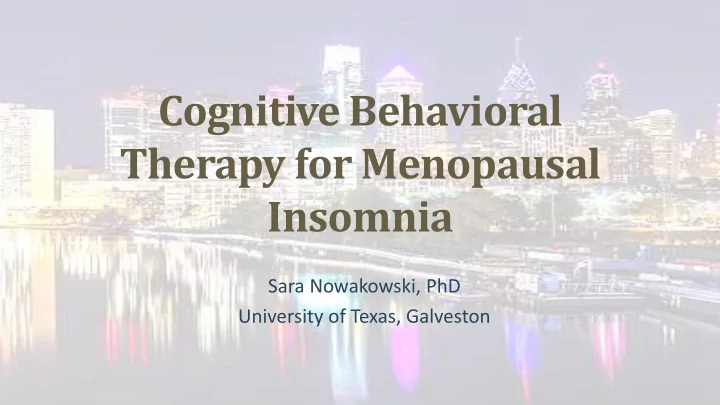

Cognitive Behavioral Therapy for Menopausal Insomnia Sara Nowakowski, PhD University of Texas, Galveston
Insomnia in Menopause • 30-60% midlife women suffer from insomnia symptoms 1,2 • Hot flashes frequently (but not always) awaken women from sleep 3,4 • Consequences of menopausal insomnia include: ↑ healthcare utilization & costs 5 ↑ disability 5 ↑ risk of medical and psychiatric conditions (e.g., CVD, depression) 6 ↓ quality of life 7 • Tailoring interventions to treat both insomnia and hot flashes may improve sleep and quality of life in midlife women 1 NIH, 2005. State-of-the-Science Conference statement: Management of menopause-related symptoms. Ann Intern Med, 142(12), 1003-13. 2 Kravitz et al., 2008. Sleep, 31(7 ), 979-90. 3 Ensrud et al., 2009. Menopause, 16(2), 286-92. 4 Shaver et al, 1988. Sleep, 11(6), 556-61. 5 Bolge et al., Menopause, 17(1), 80-6. 6 Vgontzas et al., 2009. Sleep,32(4) , 491-7. 7 Timur et al., 2009. Maturitas, 64(3), 177-81.
Objective To preliminarily examine the efficacy of cognitive behavioral therapy (CBT) for menopausal insomnia in a pilot study compared to menopause education control in midlife women CBT Control vs
What is Cognitive Behavioral Therapy (CBT) for Menopausal Insomnia? Combine CBT for Insomnia & CBT for Hot Flashes Behaviors: A set of instructions for changing behaviors that are incongruent with good sleep or ability to cope with hot flashes Cognitions: Address thoughts related to sleep and hot flashes that interfere with good sleep increase hot flash bother Reduce suffering (hope, realistic expectation, acceptance)
CBTMI Components Technique Aim Sleep restriction Restrict time in bed to improve sleep depth & consolidation Stimulus control In bed only when asleep to strengthen bed/bedroom as sleep stimulus Cognitive therapy Address maladaptive beliefs about sleep & hot flashes Sleep hygiene & Promote habits that help sleep & hot flashes eliminate bad habits & hot flash triggers Hot flash coping Relaxation training Reduce physical/psychological arousal
Menopause Education Control (MEC) • A single 50-minute session • Introduced as self-help intervention • Educational Handouts • Discuss menopausal symptoms & sleep hygiene
Procedures Study Duration = 20 weeks • Screen Week • S1 • Survey 1-2 • S2 Week • PSG* 3-10 • S3 • Survey Week • S4 Follow- 11-12 • PSG Online Up Month Survey 1 Online Follow- Up Survey Month 3 *PSG = polysomnography S = session
Inclusion-Exclusion Criteria Insomnia Disorder Diagnostic Criteria Inclusion criteria - Predominant complaint of dissatisfaction • peri/post women; (STRAW +10 criteria) with sleep quantity or quality assicated • Insomnia disorder diagnosis (DSM-5) with (≥ 1 symptom): 1. Difficulty initiating sleep • ISI>10 or PSQI>8 2. Difficulty maintaining sleep (frequent • ≥ 1 nocturnal hot flash/night awakenings or problems returning to sleep after awakenings) 3. Early-morning awakening with inability to Exclusion criteria return to sleep • Surgical or chemotherapy/radiation-induced menopause - Causes significant distress or impairment • Cognitive impairment in functioning. • Psychotic disorder, substance use disorder, bipolar disorder ≥ 3 nights / week ≥ 3 months • Recent initiation/change in treatments that may impact sleep or HF - Occurs despite adequate opportunity to • As needed use of medications or herbs that may affect sleep or HF sleep • Comorbid sleep disorders [PLMI > 15; OSA (AHI > 15)]
Sleep Measurements Insomnia Severity Index 7 item validated self-report scale to assess insomnia ≥ 10 = detect insomnia -8.4 point change score = moderate improvement Actigraphy Wrist-worn device to objectively measure sleep Daily Sleep Diary 7-day diary modeled after Consensus Sleep Diary 1 (9 items) Sleep Efficiency Total Sleep Time x 100 Time in Bed E.g., if a woman spends 8 hours in bed in a given evening, but only actually sleeps for 4 of those hours, her sleep efficiency for that evening would be 50% Wake After Sleep Onset Amount of time an individual is awake during the night after she falls asleep 1 Carney et al., 2012. SLEEP, 35(2), 287-302.
Baseline Characteristics (N=40) Measure CBT-I MEC p Age, M (SD) 53 (5.2) 56 (7.1) .10 Race/ethnicity, N (%) nonwhite 12 (63) 5 (25) .04 Menopause stage, N (%) peri 6 (30) 8 (40) .68 Sleep hot flashes/night (self-report), M (SD) 1.7 (1.2) 1.4 (.4) .52 Insomnia Severity Index, M (SD) 15 (3.4) 16 (4.3) .59 Sleep Diary Sleep Efficiency %, M (SD) 79 (12.2) 84 (9.3) .20 Wake After Sleep Onset mins, M (SD) 38 (21.0) 30 (28.8) .34 Actigraphy Sleep Efficiency %, M (SD) 85 (4.1) 85 (4.8) .96 Wake After Sleep Onset mins, M (SD) 42 (11.8) 44 (15.0) .77
Insomnia Severity Index Effect P-value Time 0.001 Condition 0.007 Interaction 0.003
Sleep Efficiency Sleep Diary Actigraphy Time p = .002 Condition p = .006 Condition p = .017 Interaction p < .001 Interaction p = .01
Time Awake After Sleep Onset Sleep Diary Actigraphy Time p = .007 Time p = .013 Condition p = .05 Condition p = .009 Interaction p < .001 Interaction p = .005
Similar Outcomes McCurry et al 2016 Current study 18 Telephone-based CBT-I MsFlash 16 106 peri-/post-menopausal women (age 40-65) 14 ISI ≥12 & ≥ 2 daily hot flashes 12 Treatments 10 CBT-I CBT-I: 6 telephone sessions in 8 8 MEC weeks 6 MEC: 6 telephone sessions - information about menopause and 4 women’s health 2 0 McCurry, JAMA Internal Med 2016 bsln wk 8 wk 24 bsln wk 8 wk 12 wk 20
Summary For midlife women experiencing insomnia and hot flashes, cognitive behavioral therapy for menopausal insomnia led to clinically meaningful improvements 1. insomnia severity 2. sleep efficiency (actigraphy & sleep diary) 3. time awake after sleep onset (actigraphy & sleep diary)
Acknowledgements Co-Investigators : Rachel Manber (K23 primary mentor) Rebecca Thurston (K23 co-mentor and NAMS mentor) NIH Grants : K23NR0140089 Nowakowski UL1TR001439 UTMB Institute of Translational Science K24HL123565 Thurston
CBT-I Resources
Recommend
More recommend